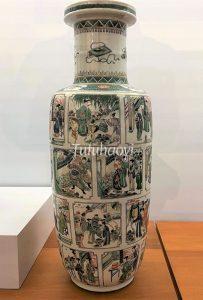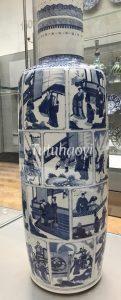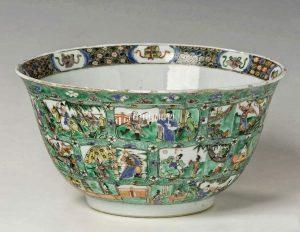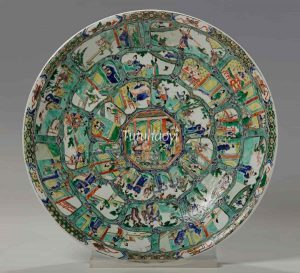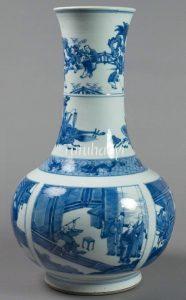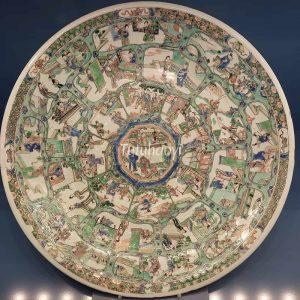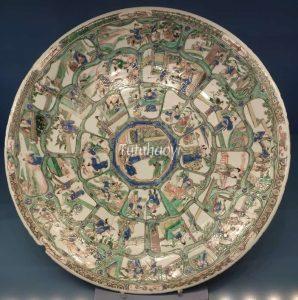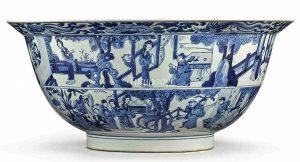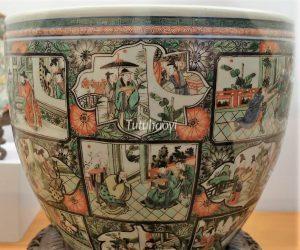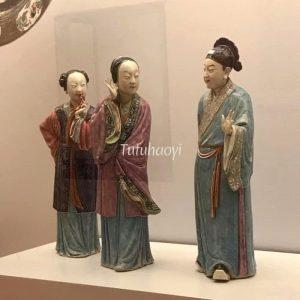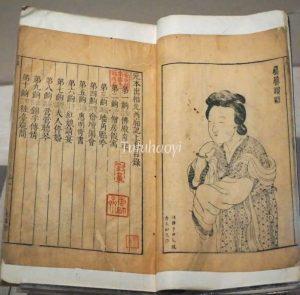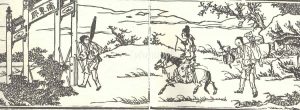Romance of the Western Chamber
西厢记
© Tutuhaoyi.com owns the copyright of the description content for the images attached. Quoting all or part of the description content on this page is permitted ONLY IF ‘Tutuhaoyi.com’ is clearly acknowledged anywhere your quote is produced unless stated otherwise. (本页描述内容版权归Tutuhaoyi.com所有,转发或引用需注明 “Tutuhaoyi.com”, 侵权必究, 已注开源信息的条目除外。)
The Chinese classic drama Romance of the Western Chamber (西厢记) depicts a romantic story of a young couple in the Tang dynasty. The name of the play has also been translated into The Story of the Western Wing, The West Chamber, and Romance of the Western Bower, etc. It stands as one of the most influential Chinese dramatic works, and has been a popular subject in woodblock prints and porcelain paintings since Ming dynasty.
While there have been differing opinions regarding the authorship of this play, with some attributing it to Guan Hanqing 关汉卿, most literary research credits the Yuan playwright Wang Shifu (王实甫 1250–1336) as the author. The descriptions of the story scenes on Tutuhaoyi 图图好意 are based on Wang Shifu’s version of the play.
Plot content:
Zhang Gong 张珙 (styled Junrui 君瑞, nickname Scholar Zhang 张生), a young scholar lodging at the Monastery of Universal Salvation encountered Cui Yingying 崔莺莺, the daughter of former Prime Minister of the Tang court. Their affection blossomed through mutual appreciation of poetry. However, a rebel Sun Feihu (nicknamed Sun the Flying Tiger 孙飞虎) coveted Yingying’s beauty and attempted to abduct her from the temple. As the monastery was besieged by ruffians, Yingying’s mother, Lady Zheng 郑氏, promised her daughter’s hand in marriage to whomever could rescue her from the bandits. Scholar Zhang had his letter for help sent to his childhood friend Du Que 杜确, nicknamed General White Horse 白马将军. General Du led five thousand warriors towards the temple and successfully subdued the bandits.
Unexpectedly, Lady Zheng regretted the marriage proposal afterwards due to differences in their social status. She offered Scholar Zhang monetary compensation and suggested him to be Yingying’s sworn brother instead. Stricken with sorrow, Scholar Zhang fell ill, and Yingying was distraught. With the help of Yingying’s clever maid Hongniang 红娘, they exchanged secret letters and eventually managed to meet clandestinely. However, their forbidden affair was soon discovered by Lady Zheng, who intended to punish them. Through Hongniang’s eloquent defense, Lady Zheng reluctantly agreed to the marriage on the condition that Scholar Zhang passed the imperial examinations. To the delight of the young lovers, Scholar Zhang succeeded, and they finally became a couple.
Summary by Rachel Ma
Pictorial illustration of this story (work in progress):
Act I
Funeral Halt at the Secluded Monastery 萧寺停丧
Scholar Zhang embarking on his journey to sit for civil-service examinations 张生赶考 (应举登途)
Scholar Zhang and Cui Yingying’s encounter in the Salvation Monastery 佛殿奇逢 (惊艳)
Scholar Zhang renting a room in the monastery 僧房假寓 (禅关假馆)
Scholar Zhang and Cui Yingying exchanging verses in the garden 唱和东墙 (墙角联吟)
Act II
Sun Feihu besieging the monastery with a gang of bandits 彪贼起兵 (乱倡绿林)
Huiming delivering a letter for help 惠明寄书 (溃围请救)
Hongniang’s Banquet Invitation 红娘请宴
Scholar Zhang getting drunk due to Madame Cui’s broken promise 张生醉酒 (崔母悔婚)
Yingying listening to the qin zither playing 莺莺听琴 (琴心写恨)
Act III
Repudiation of the Billet-Doux 张生跳墙 (乘夜踰垣)
Hongniang Enquiring After Scholar Zhang’s Health 倩红问病
Act IV
Consummation of love from Western Chamber 月下佳期
Hongniang in the Dock 堂前巧辩 / 拷红
Farewell feast at the pavilion 长亭送别 (哭宴)
Scholar Zhang’s startled dream at Caoqiao Inn 草桥惊梦
Act V
Fig 1: rouleau vase with overglaze enamelled decoration, Kangxi period (1662–1722), Qing dynasty, courtesy of The Guimet Museum, Paris; Photograph by Raid Kneife
Fig 2: rouleau vase with underglaze blue decoration, Kangxi period (1662–1722), Qing dynasty, courtesy of the Victoria & Albert Museum, London; Photograph by JP Kim
Fig 3-4: a set of porcelain bowl and dish with overglaze enamelled decoration, Kangxi period (1662–1722), Qing dynasty, courtesy of Groninger Museum, Groningen, The Netherlands
Fig 5: porcelain vase with underglaze blue decoration, Kangxi period (1662–1722), Qing dynasty, courtesy of the Metropolitan Museum of Art, New York
Fig 6-7: a pair of famille verte porcelain chargers, Kangxi period (1662–1722), Qing dynasty, courtesy of Munich Residence Museum; Photograph by Jason Ooi
Fig 8: porcelain bowl with underglaze blue decoration, Kangxi period (1662–1722), Qing dynasty, courtesy of the Jie Rui Tang Collection
Fig 9: porcelain jar with overglaze enamelled decoration, Kangxi period (1662–1722), Qing dynasty, courtesy of The Guimet Museum, Paris; Photograph by Raid Kneife
Fig 10: porcelain figures with overglaze enamelled decoration, Qing dynasty (1644–1911), courtesy of The Guimet Museum, Paris; Photograph by Raid Kneife
Fig 11: woodblock print Romance of the Western Chamber《元本出相北西厢记》, Ming dynasty (1368–1644), courtesy of the Chinese National Library
Fig 12: woodblock printed illustration of the play Romance of the Western Chamber, printed in 1498 in Beijing, from Ming kan xixiangji quan tu (Complete Set of Illustrations of Romance of the Western Chamber), Shanghai: Shanghai Fine Arts Publishing House, 1983, p. 21
